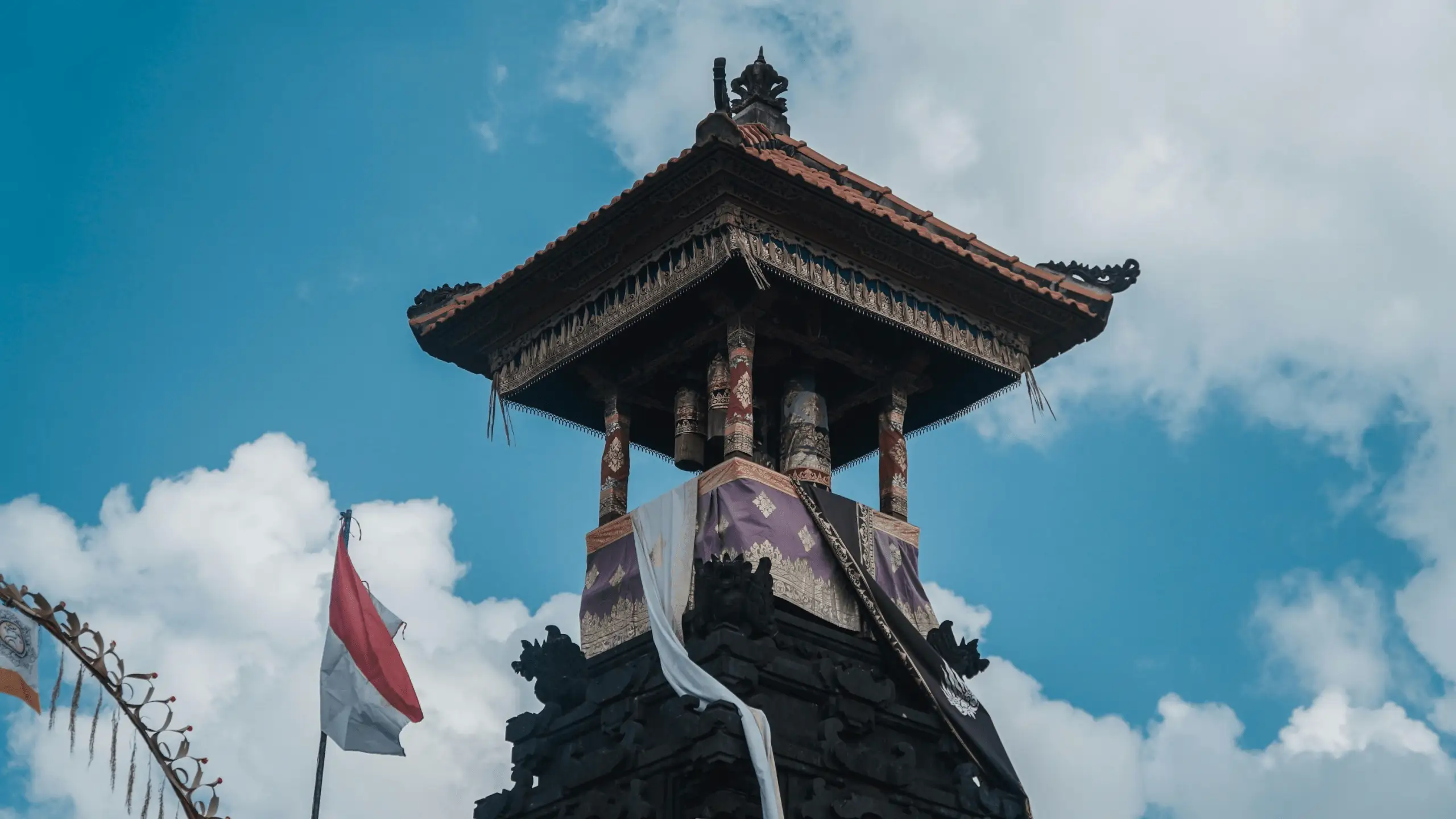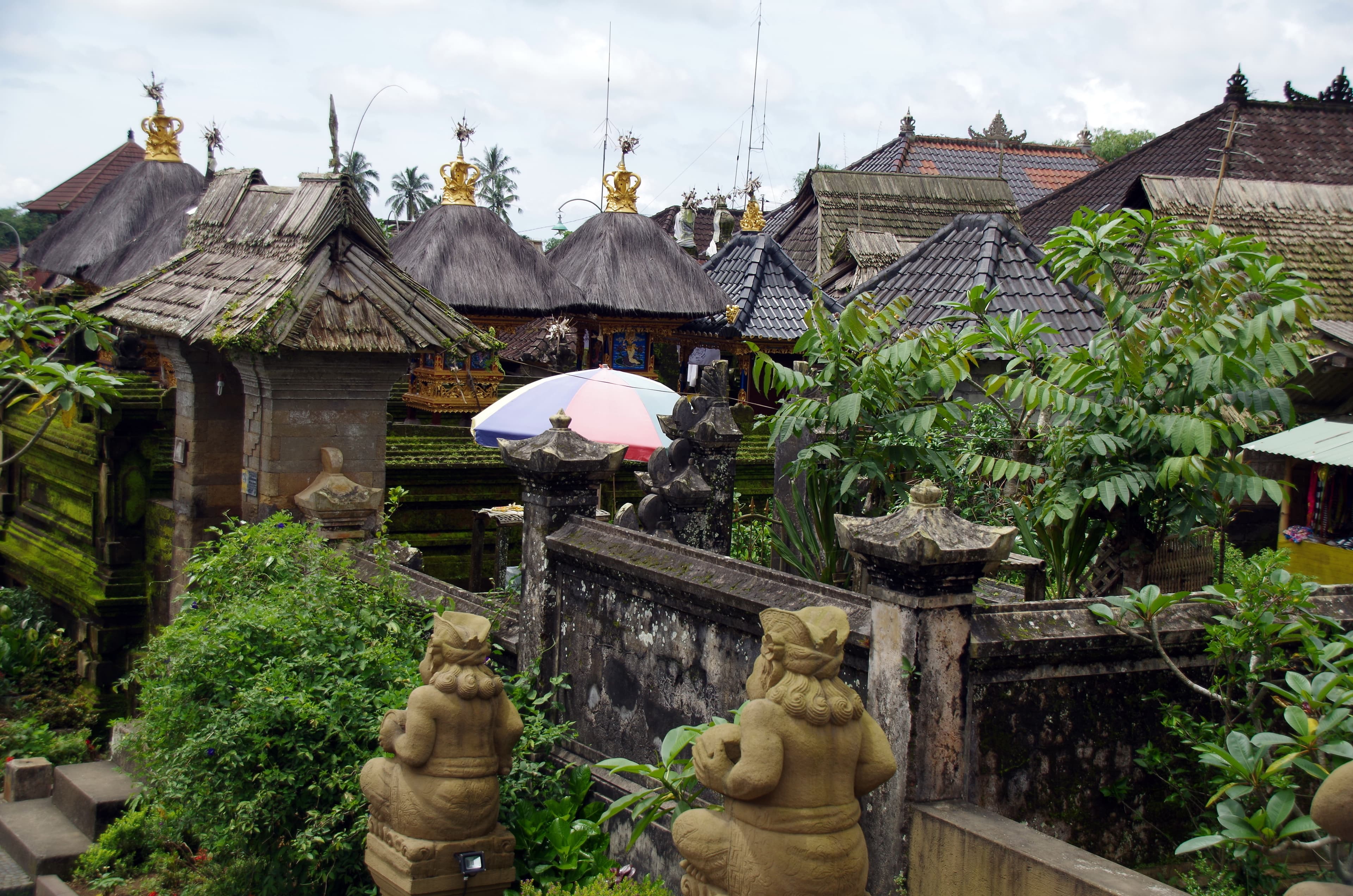
The Wuwungan Crown
Symbol of Bali’s Spiritual Architecture
The Wuwungan Crown
The Wuwungan or crown-like ornament is an important architectural and symbolic element in Balinese architecture, particularly seen in the roofs of temples, traditional houses, and other significant structures. This ornament represents the spiritual connection between the human realm and the divine realm. It holds both aesthetic and cosmological significance, and its history can be understood through its role in Balinese Hinduism, architecture, and the broader cultural context of Bali.
1. Origins and Symbolism of Wuwungan
The Wuwungan as an architectural feature has deep roots in Balinese Hindu cosmology and spiritual beliefs. The term itself is often used to refer to a decorative crown-like ornament found at the peak of Balinese roofs, especially on temples and sacred structures. It is believed to symbolize the connection between the divine and earthly realms, and it embodies the central cosmological concept of Mount Meru, the mythical mountain that represents the axis of the universe.
Cosmological Significance:
- Mount Meru: In Hindu and Buddhist cosmology, Mount Meru is considered the center of the universe, and it is the dwelling place of the gods. Balinese temples, in particular, are designed to symbolically represent this sacred mountain, with the Wuwungan at the top symbolizing the peak of Mount Meru. The pyramid shape and the tiered structure of the Wuwungan echo the layers of the mountain, where the gods are believed to reside at the top, and humans inhabit the lower levels.
- Connection to Heaven: The Wuwungan at the top of the roof is designed to represent the point where the temple or structure connects to the heavens. In Balinese philosophy, the higher the point, the closer it is to the divine. This reflects the idea of spiritual ascent—from the mundane world at the base of the building to the sacred realm at the apex.
Divine Order:
The roof and its Wuwungan element follow the concept of the vertical axis. The highest point of the building (where the Wuwungan is placed) serves as the symbolic meeting point between the human and divine realms. The sacred geometry of this structure is designed to maintain cosmic harmony and facilitate communication with the gods.

Wuwungan in rooftops of a village
2. The Role of Wuwungan in Balinese Temples
Balinese temples (pura) are often constructed in a tiered style, with each tier representing different levels of sanctity and sacredness. The Wuwungan is a significant feature in the temple's highest structure, whether it be the meru (a multi-tiered pagoda-like structure dedicated to a specific deity) or other temple buildings.
- Spiritual Hierarchy: In Balinese temples, the Wuwungan not only serves as a decorative element but also indicates the importance of the temple structure. The highest structure is always the most sacred, and the Wuwungan placed on top is a symbol of spiritual elevation. This reflects the hierarchy within the temple complex, where the most important shrines or altars are located at the highest point, closest to the gods.
- Symbol of Divinity: The tiered structures and Wuwungan crowns are intended to represent Mount Meru, the cosmic center of the world in Hindu cosmology. As such, the Wuwungan has a sacred and symbolic purpose—it is not only decorative but also integral to the temple's ritual function. It channels spiritual energy and is often part of ceremonial practices to honor the gods.
Meru Temple Architecture:
In particular, the Meru is a type of temple structure commonly found in Bali, especially in temples dedicated to high-ranking deities like the gods of Mount Meru. The Wuwungan is often placed at the top of these multi-tiered Meru roofs, with each tier representing a level of divine hierarchy, and the Wuwungan at the top signifying the divine summit.
3. The Evolution of Wuwungan in Traditional Balinese Houses
In addition to temples, Wuwungan can also be found in traditional Balinese houses. These houses are designed around a central family temple or sacred space, where the Wuwungan is sometimes placed on the roof of a small shrine or altar within the compound.
- Sacred Family Spaces: In Balinese family compounds, the Wuwungan represents the connection between the family and the divine. The highest point in the compound is where the family temple or shrine is located, and the Wuwungan atop the temple symbolizes the spiritual link between the family and their ancestors and gods.
- Ritual Significance: In traditional Balinese society, the Wuwungan is not only a decorative element but is closely tied to the rituals performed in these spaces. Offerings are made to deities and ancestors at the family temple, and the Wuwungan serves as a focus for these rituals, helping to maintain the spiritual balance of the household.
4. Material and Construction of Wuwungan
The materials used in creating the Wuwungan have evolved over time, but traditionally, they are made from natural materials such as woven bamboo, wood, and thatched palm leaves. These materials reflect Bali's deep connection to nature and the environment, which is central to the Tri Hita Karana philosophy (the Balinese concept of harmony between humans, nature, and the divine).
- Bamboo and Palm Leaves: The use of bamboo, palm leaves, and other organic materials is not only practical but also symbolic. Bamboo, for example, is considered a sacred plant in Bali, symbolizing strength, flexibility, and spiritual growth.
- Craftsmanship: The making of the Wuwungan is often an intricate, highly skilled craft passed down through generations. Balinese artisans carve and weave these elements with symbolic patterns and religious motifs, ensuring that the craftsmanship aligns with the spiritual purpose of the structure.
5. Wuwungan in Modern Bali
While modernization and urbanization have affected Bali's landscape, the symbolic and architectural importance of the Wuwungan remains significant, particularly in traditional and ritual contexts. In recent years, preservation efforts have been made to maintain traditional architectural practices, even as tourism and commercial development transform the island.
- Cultural Preservation: There are initiatives to protect Bali’s traditional architectural heritage, and the Wuwungan remains a key element in these efforts. Balinese architects are also incorporating modern materials in some cases but continue to follow traditional designs that respect the spiritual meaning of these elements.
- Spiritual Tourism: The rise of spiritual tourism in Bali has also led to a renewed interest in understanding the role of elements like the Wuwungan. Visitors to the island who are interested in Balinese culture and religion often seek out temples and traditional villages where they can witness these unique architectural features.
Conclusion: The Legacy of Wuwungan
The Wuwungan is much more than a simple decorative element on a Balinese roof—it is a powerful symbol that represents the spiritual connection between the earthly and divine realms. Rooted in Hindu cosmology, particularly the concept of Mount Meru, the Wuwungan embodies the cosmic order and the hierarchical structure of the universe.
From its early use in temples to its integration into family homes, the Wuwungan reflects Bali's deep cultural values of balance, harmony, and spirituality. Its history is inseparable from the spiritual and architectural traditions of the island, and it continues to be an important symbol of Balinese identity today.

Wuwungan connecting the earth and the divine